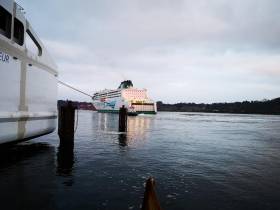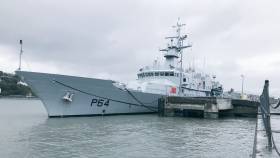Displaying items by tag: Delivery Voyage
New Ferry Delivered to Stena Expected to Be Sailing on Dublin-Holyhead Route by January
The first of five new ferries from China, Stena has received and expects to have the vessel (see: following trials) operating on the key Dublin to Holyhead route by January.
According to the Belfast Telegraph, Stena Estrid will be formally handed over at the Weihai shipyard to begin its approximately 10,000-nautical mile journey to Dublin, which will take a month.
A sister ship is expected to join the ferry company's Belfast to Liverpool service with the Stena Edda by late 2020, while the Stena Embla will start carrying passengers in 2021.
"Today has been six years in the planning," said Stena technical operations director Bjarne Koitrand.
"We are delighted to finally take ownership of the first of our five new ships.
"With the new crew now in place, they can start the long journey to the Irish Sea."
To read more click here, about the introduction 42,400-tonne ship which can carry 1,000 passengers, 210 freight vehicles and 120 cars.
W.B. Yeats Now In Danish Waters Before Delivery Voyage to Ireland Via France
#Ferry- Irish Ferries brand new W.B. Yeats which departed from its German shipyard yesterday, has it transpired seemingly taken a different delivery route bound for Ireland as previously outlined, writes Jehan Ashmore.
The 54,983 gross tonnage W.B. Yeats having departed shipbuilder Flensburger Schiffbau-Gesellschaft (FSG) in Flensburg, was understood to be taking a short-cut through the Kiel Canal, Germany into the North Sea. Instead, however the 194m cruiseferry headed northward into the Kattegat, the sea between Denmark and Sweden.
The new €147m cruiseferrry, accommodating 1,885 passengers and crew and 1, 200 vehicles, along with fleetmates, is a client of Matrix Ship Management which has its head office based in Limassol. The port city is a renowned international hub for ship management.
Afloat tracked the Cypriot flagged W.B. Yeats this morning off the Danish coast between Saeby on the mainland and Læsø, the largest island in the Kattegat. Alongside of the cruiseferry, was the Latvian flagged Zircon apparently supplying bunkers (fuel).
It remains uncertain as to which way W.B. Yeats is to continue the maiden delivery route to Dublin en-route via Cherbourg, where these ports form the direct Ireland-France route the cruiseferry is to enter service in mid-March 2019, and not this summer as originally scheduled due to delays caused by sub-contractors cited FSG.
On the capital-continental route W.B. Yeats will offer customers a total of 440 cabins, including luxury suites with private balconies. Such a feature from rivals, Brittany Ferries was introduced in 2004 when flagship Pont-Aven was launched on the Cork-Roscoff route.
W.B. Yeats is understood to be scheduled to arrive in Cherbourg in the early hours of Wednesday, before continuing also next week its maiden delivery voyage to Dublin Port.
As of this afternoon, the tanker Zircon remains alongside the largest newbuild ever ordered by Irish Continental Group and the first from a German shipyard, FGS, where Brittany Ferries cruiseferry Honfleur was launched on Friday. The liquified natural gas (LPG) powered cruiseferry built for English Channel service is due also to enter service next summer.
Returning to Danish waters, where working in relative proximity of W.B. Yeats this afternoon was the diminutive domestic ferry, Margfrete Laesoe which compared to W.B. Yeats, is only 3,688 in gross tonnage terms.
Margfrete Laesoe operated by Færgeselskabet Læsø K/S, has capacity for just over 500 passengers and 76 cars, on crossings made between Vestoroe on Læsø and Frederikshavn on the Jutland peninsula. The service taking 1 hour 30 minutes to complete.
Currently, Irish Ferries Dublin-Cherbourg route takes between 17 and 19 hours to complete and is served by cruiseferry Oscar Wilde and ropax Epsilon offering an economy no-frills service.
Naval Service Latest Newbuild LÉ George Bernard Shaw Makes Delivery Voyage to Cork Harbour
#NavalService - The newest Irish Naval Service Offshore Patrol Vessel (OPV) LÉ George Bernard Shaw completed a delivery voyage from a UK shipyard to Cork Harbour, writes Jehan Ashmore.
Minister with responsibility for Defence, Mr Paul Kehoe TD, welcomed the arrival of LÉ George Bernard Shaw to the Naval Base in Haulbowline on Thursday. Commenting on the arrival, Minister Kehoe said it demonstrates the Government’s commitment to ongoing investment in the Defence Forces. “In Budget 2019, we have committed to spend an additional €29m on capital projects”
LÉ George Bernard Shaw was built by Babcock Marine's Shipbuilding Yard in Appledore, north Devon, England from where as Afloat previously reported the OPV90 carried out sea-acceptance trails in the Bristol Channel. The trials completed successfully, were attended by representatives from the Department of the Defence and the Defence Forces.
The delivery of LÉ George Bernard Shaw to Cork Harbour completes the current Naval Service ship replacement programme of four new OPV90/P60 class vessels since 2014. The class also dubbed the 'Playwright' sisters, began with leadship LÉ Samuel Beckett in 2014, LÉ James Joyce in 2015 and LÉ William Butler Yeats entering service in 2016. The value of the three-ship contract was €199.4m.
In June 2016 an agreement was reached with Babcock International for the provision of an additional OPV90/P60 to be built also at their Appledore shipyard. The agreed contract value for the further ship is €67m inclusive of VAT. This aligns with the project planning process in place under the White Paper on Defence, which will determine the Defence Organisation’s maritime capability requirements.
The LÉ George Bernard Shaw represents six of the current Irish Naval Service fleet having been built in Appledore.The new OPV will be formally named and commissioned as LÉ George Bernard Shaw at a later date.
The Minister said "The addition of the new ship will bring relief to older vessels and support a planned programme of refit and maintenance. LÉ Roisin and LÉ Niamh will receive significant mid-life refits in the period ahead.”
In recent weeks the issues of low-pay, coupled with staff shortage have been raised. In response Minister Kehoe said the Department will continue to work closely with military management to address challenges in the Naval Service.
“The current strength of the Naval Service is just over 1,000 personnel and is at approximately 92% of its establishment of 1,094. There is ongoing recruitment to the Naval Service. Any challenges in delivering the full outputs across the Defence Forces are being managed and closely monitored by the Defence Forces and the Department of Defence under my direction on a daily basis.”

























































